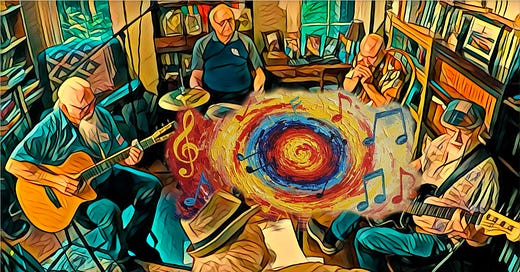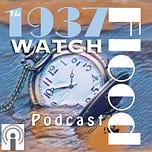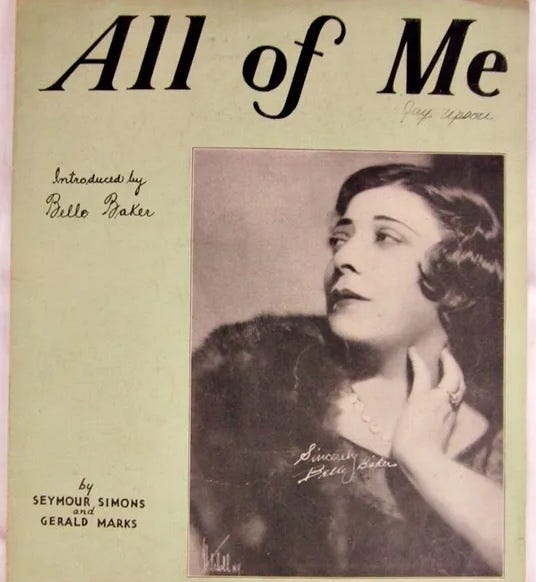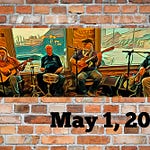Whenever The Flood appears in public — as it did at Bahnhof WVrsthaus & Biergarten earlier this month — it positions itself the way most bands do at gigs: in a simple straight line politely facing the audience.
Nothing novel in that, of course, just the time-honored way of letting players and listeners make eye contact, feeding off each other’s reactions as the music rolls along.
However, an entirely different geometry — a circle, not a line — frames the music that has always been featured in The Flood’s weekly podcasts.
A Table at the Center of the Songs
A table in the middle of the Bowen House’s library has been the center of the Floodisphere’s weekly rehearsal for more than three decades now.
Almost all of the nearly 800 episodes of the podcast have been recorded in that room, with a recorder happily stationed at the center of the table and all the players and visitors gathered around it.
More than one visitor to The Flood band room, imagining the years of music those walls have heard, has commented on the space’s “vibe,” as if its years of music are somehow preserved in the walls and between the very pages of the books on the shelves.
Honestly, that’s a little too new-age-y for some of us. Still, there’s no doubt that as much fun as the guys have at gigs, it never compares to the joy in the music made around that table each week. Here’s a sample from last week’s gathering.
About the Song
As reported here earlier, “All of Me” — the featured song in this week’s podcast — was an original “bad boy song” from the 1930s. "I peddled my song up and down the street,” composer Gerald Marks once noted, “and every single publisher turned it down.”
The problem was Seymour Simons’ lyric. Oh, its moaning over lonely lips and empty arms was pretty standard fare, but it was that follow-up line — "Why not take all of me?" — that publishers found, well, downright dirty by 1930s standards.
It was not until a superstar of the day — songstress Belle Baker — embraced it that the song showed promise. Baker first incorporated “All of Me” it into her act in Detroit, where it received seven encores. A few days later, she introduced it on the radio in New York.
After that, the song took off. In 1931, Mildred Bailey recorded it with Paul Whiteman’s orchestra; it went to the top of the US pop charts. Within weeks, two more versions also were charting, including Louis Armstrong’s rendition which reached No. 1 and Ben Selvin’s and his orchestra, which hit No. 19.
Now, of course, the song’s a standard. Jazz critic Ted Gioia believes the definitive version was recorded in 1941 by Billie Holiday. Click here for more of the song’s history, as reported in an earlier Flood Watch article.
More About That Table
By the way, the table at the center of The Flood’s world also was the starting point for the band’s first legacy film, 2018’s “Flood and Friends.” If you’d like to see the guys reminiscing about some of the many good people who have visited that room over the years, give this a view below:


















Share this post